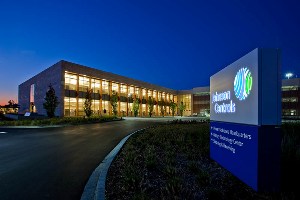Sep 18 2010
Johnson Controls (NYSE: JCI) has been awarded LEED® Platinum certification -- the highest such recognition -- by the U.S. Green Building Council, for its efforts to make its Glendale corporate campus a model of energy efficiency and sustainability. This represents the largest concentration of LEED Platinum buildings -- four -- on one site ever awarded.
Hundreds of wireless controllers and sensors communicating throughout buildings on the 33-acre site feed information to the company's Metasys® building management system which provides continuous monitoring of energy consumed per square foot. Variances can be detected and the systems adjusted automatically or with hand-held devices from any location via the Internet. Numerous other Johnson Controls energy efficiency technologies are in use as well.
"As a company that's been in the energy efficiency business for 125 years, we believe it was important to set an example and demonstrate the benefits of incorporating the latest green technologies, including many of our own, into a multi-building campus setting," said Stephen A. Roell, Chairman and Chief Executive Officer, Johnson Controls. "We're delighted that the U.S. Green Building Council has recognized our efforts with its highest award of LEED Platinum certification. Hopefully, it will encourage others to improve the energy efficiency and sustainability of their properties, be it for one building or several."
 Johnson Controls - Glendale corporate campus
Johnson Controls - Glendale corporate campus
The company's energy usage has been reduced by 21 percent, despite the recent doubling of space by adding 160,000 square feet. Greenhouse gas emissions have been reduced, annually, by more than 827,000 pounds of carbon dioxide equivalent due to the on-site solar electricity generation. Water usage has been reduced by 595,000 gallons annually by collecting and recycling rain water and the addition of low-flow fixtures.
Each employee has desktop control of workspace temperature, lighting, airflow volume, and can introduce white noise to mask sound. The environmental systems turn off in a workspace when an employee is gone for more than 10 minutes, reducing air conditioning and electrical loads.
"We have made significant strides in improving the working environment for our employees at the Corporate and Power Solutions headquarters," said Roell. "Not only are our employees more comfortable, but our engagement scores have improved as well. We believe that the working environment is a major contributing factor to employee engagement."
"Since its pioneering LEED Silver certification of the Brengel Technology Center in 2001, Johnson Controls has demonstrated unparalleled green building leadership," said Rick Fedrizzi, President and CEO of the U.S. Green Building Council. "The Johnson Controls corporate campus takes this commitment to a new level and sets an example for other organizations considering the implementation of sustainability initiatives in their facilities."
"As a USGBC member, Johnson Controls has been instrumental from very early on in helping develop the LEED rating system," said Rob Watson, Chairman, CEO & Chief Scientist of the EcoTech International Group. "I'm very impressed with the project's Platinum achievement, which demonstrates the effectiveness of the broad range of sustainable technologies and practices the company used that can be implemented by its customers worldwide. Their commitment to ongoing performance measurement, verification and optimization will ensure that the campus will continue to perform at an optimal level for many years to come."
The company expects to recoup its spend on making the campus energy-efficient within eight years, using the savings realized. The project is attracting wide-spread attention with more than 6,000 interested visitors from around the world who have toured the campus over the last few years.
Additional energy efficiency features at the Johnson Controls Corporate headquarters include:
- A geo-thermal heat pump--linked to 272 wells, each 300 feet deep--uses moderate subsurface temperatures and mass to improve the efficiency of heating and cooling.
- 31,115 square-foot ground-mounted solar photovoltaic array and 14,335 square-foot of solar film on the roof produces electricity and reduces greenhouse gas emissions. Solar thermal water heating technology is in place as well.
- Skylights and increased window area reduce use of energy for lighting.
- Window shades adjust automatically to the path of the sun.
- Lighting controls include ballasts that are intelligent, addressable and controllable for reducing artificial lighting and harvesting natural daylight.
- 3-acre parking lot resurfaced with permeable paving blocks allowing rainwater and snowmelt to be collected and retained on-site.
- Rooftop rain water collection, filtering and storage for use in flushing water closets and urinals.
Source: http://www.johnsoncontrols.com/